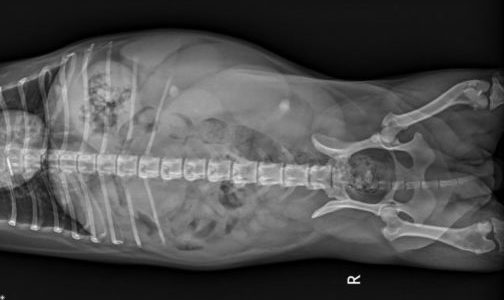Pyometra: A Life-Threatening Infection

Pyometra: A Life-Threatening Infection
Every morning at about 5 am, the overnight team of ER doctors at the Animal Medical Center sends an email with the list of the overnight admissions. Last week, two canine patients were listed as being admitted with a diagnosis of pyometra. Both dogs were so sick they underwent emergency surgery in the middle of the night to treat their pyometra.
What is pyometra?
Pyometra is a bacterial infection of the uterus. The most common bacterium identified in pyometra is E. coli, which probably originates in the stool and ascends into the uterus. It often occurs about one month after a dog or cat has been in heat. In both dogs and cats, middle-aged females are at risk. About 25% of unspayed dogs will develop pyometra before age of 10. Oriental purebred cats have a higher risk of pyometra than non-purebred cats. Oriental purebred cats and Sphynx, Siberian, Ocicat, Korat, Ragdoll, Maine Coon and Bengal develop pyometra at a younger age than the general cat population. If your cat is an unsprayed female of a high risk breed, the next paragraph is a must read.
How would I know if my dog or cat has pyometra?
Early in the course of pyometra, there may not be any clinical signs. As the infection worsens, dogs may stop eating, act lethargic, vomit, drink lots of water and urinate excessively.
You might notice a white or bloody vaginal discharge. As the uterus fills with pus, your dog’s tummy might look bloated. If these clinical signs are missed, the infection progresses and can spread throughout the bloodstream. Ultimately, your veterinarian will make the diagnosis based on an abdominal x-ray or ultrasound. An x-ray of a dog with pyometra is shown above.
Because cats are not simply little dogs, pyometra looks different in the cat. Female cats are much less likely to act sick when they have pyometra until the infection is advanced and the uterus is very large. Because of the fastidious nature of cats, vaginal discharge is easily missed. Cat or dog, pyometra can be so serious that emergency surgery is required and your pet could end up in ICU.
How is pyometra treated?
The short answer to this question is surgical removal of the uterus. But the severity of illness may require extensive treatment prior to and following surgery. Pets with pyometra are frequently dehydrated, febrile and may have low blood sugar that must be corrected before surgery. In preparation for surgery, intravenous fluids, antibiotics and glucose may be administered. Veterinarians reserve non-surgical treatment of pyometra for valuable breeding animals.
Will my pet recover from pyometra?
Despite the urgency of surgery to remove the infected uterus from a critically ill pet, nearly all will make a full recovery. Fatalities in dogs tend to occur when the uterus is leaking pus into the abdominal cavity.
Since pyometra is a uterine infection caused in part by the normal reproductive cycle of cats and dogs, one of the advantages of spaying your female cat or dog is prevention of pyometra.
Pyometra can be found in many species, including this recent report about a white Bengal tiger who was successfully treated by veterinarians at Oregon State University.






























